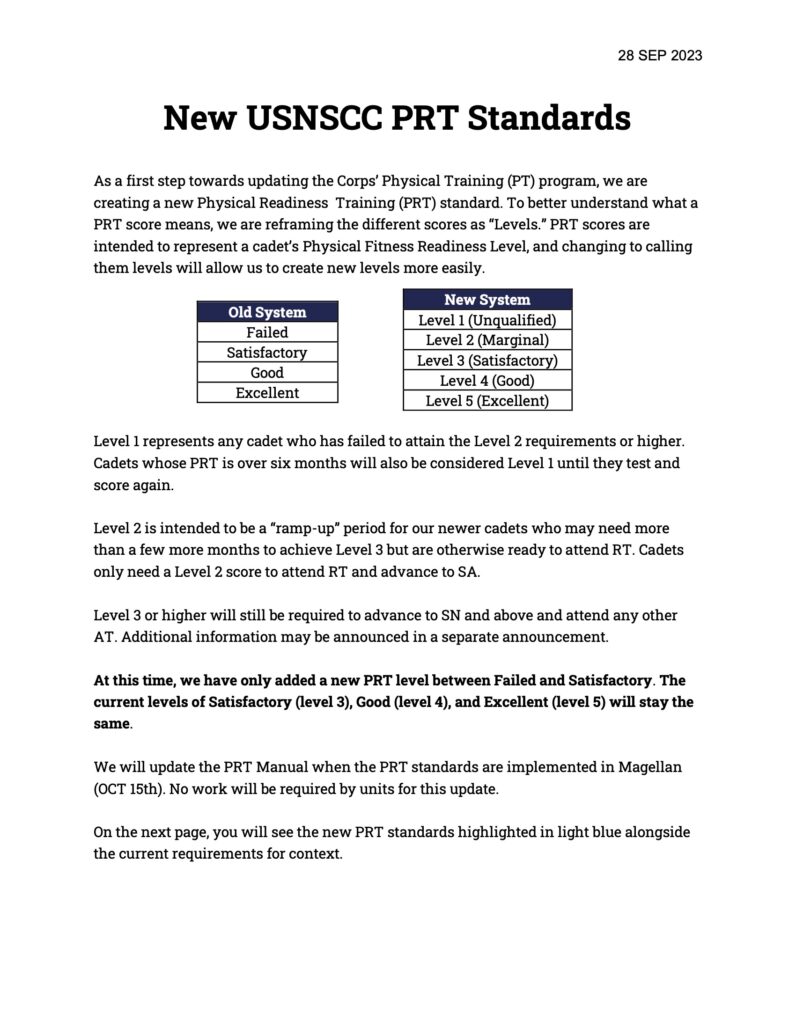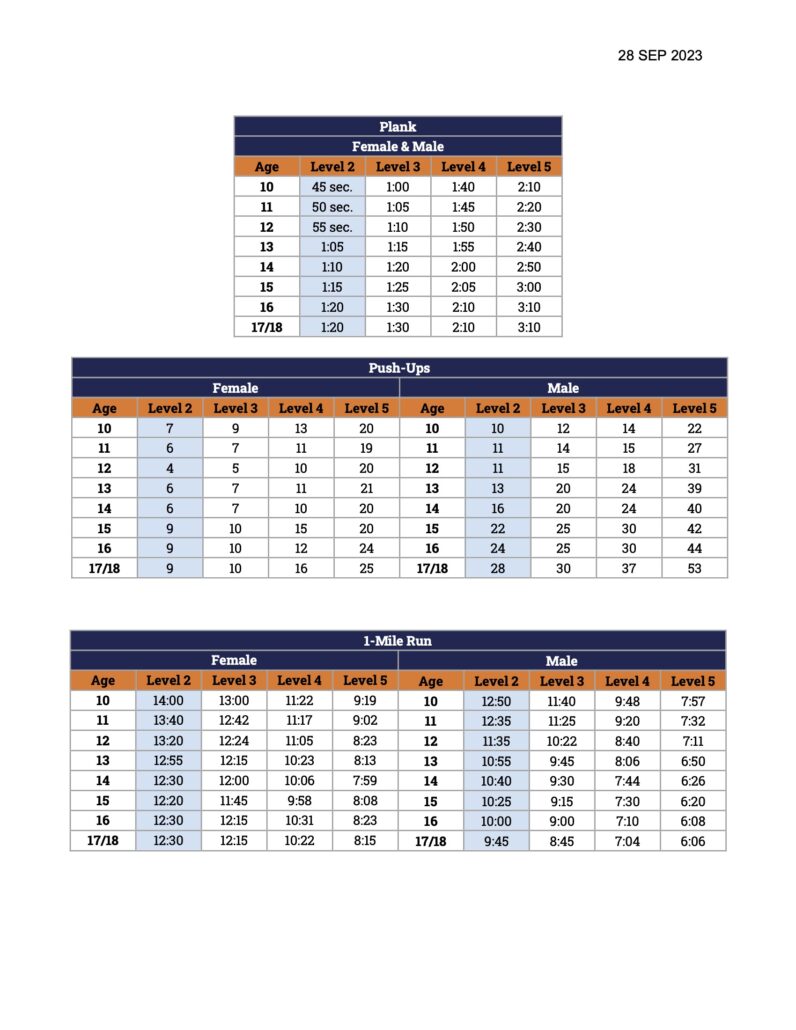PRT EFFECTIVE 15OCT23
1.01 INTRODUCTION AND GOALS
(a) This policy outlines how, when, and why USNSCC units should conduct the required USNSCC Physical Readiness Test (PRT).
(b) The USNSCC requires regular completion of the PRT because it:
(1) Encourages a culture of physical fitness;
(2) Simulates an important aspect of military life, which is important considering the fundamental military nature of USNSCC training; and
(3) Ensures every cadet is physically able to safely participate in most USNSCC drills and NHQ-approved trainings. The vast majority of USNSCC activities require some degree of cardiorespiratory fitness and muscular strength and endurance.
(i) Cardio-respiratory fitness. The ability of the heart and lungs to deliver oxygen to working muscles. It is associated with the ability to carry out strenuous work for long durations without undue fatigue. The 1.0 mile run/walk components of the PRT are indicators of cardio-respiratory endurance.
(ii) Muscular strength and endurance. The ability to sustain muscle contractions over a period of time without undue fatigue. The plank and push-up events indicators of muscular endurance. Although there is no single endurance test that measures the endurance of all muscles, the plank serves as a measure of abdominal muscle endurance while the push-up measures upper body muscular endurance.
1.02 PHYSICAL FITNESS REQUIREMENT
(a) Every Sea Cadet and League Cadet must take and pass the PRT during each Spring and Fall cycle in order to satisfy the USNSCC’s physical fitness requirement of membership. See USNSCC Regulations, Section 5.01(d).
(b) No cadet will be eligible to participate in NLCC Orientation, NSCC Recruit Training, or NLCC/NSCC Advanced Training, unless he/she has taken and passed thePRT within the preceding six (6) months.
(c) Except as provided for certain injury/illness cases, see Section 1.07, no cadet will be eligible to advance to the next rate, unless he/she has taken and passed the PRT within the preceding six (6) months.
(d) A cadet who does not pass at least one PRT during his/her yearly enrollment (and who, therefore, is ineligible for advancement, or participation at training) may be re- enrolled for one additional enrollment period only if the cadet has made substantial progress towards meeting the physical fitness requirement. If the cadet has not made substantial progress, the unit Commanding Officer may separate, or, if eligible, honorably discharge the cadet from the USNSCC.
1.03 MANDATORY PARTICIPATION
(a) The unit CO must ensure as close to 100% cadet participation as possible on the date the PRT is scheduled. Re-take days should be kept to the minimum necessary to obtain 100% participation for the cycle.
(1) The unit CO may excuse a cadet from drill on the designated PRT day for good reason (e.g., illness, injury, important family commitment, etc.). However, the cadet must still complete the PRT requirement for that cycle.
(2) Any cadet who is either absent on the scheduled PRT date, or who is present but unable to take the test, must take the test at the next drill at which he/she is present and able to do so.
(b) Volunteers who wish to lead by example in the important area of physical fitness may take the PRT along with, and under the same rules, as cadets. No volunteer shall be required to take the PRT. Standards for adults, based on age and sex, are reproduced in Section 2.13.
1.04 PRT CYCLES
(a) Spring and fall cycles. Every Sea Cadet unit and League Cadet training ship and company will conduct the PRT at least twice per calendar year, in two PRT “cycles”— the Spring Cycle and the Fall Cycle.
- (1) Spring Cycle: Should be conducted between the months of March and May.
- (2) Fall Cycle: Should be conducted between the months of September and
November.
(3) The goal of having two PRT cycles in the spring and fall is to keep each cycle approximately six months apart, and to ensure all cadets will have a current PRT forthe upcoming summer and winter training periods.
1.05 SCORING
(a) Satisfactory. A cadet passes the PRT when he/she achieves at least a “Satisfactory” score in each of the three required PRT exercises—1-mile run, plank, and pushup (or approved ADA substitute(s), see Section 1.08). All three exercises must be taken as a single test, at the same time, on the same date.
(b) Good. A cadet achieves a “Good” score on the PRT when he/she achieves at least a “Good” score on each of the three PRT exercises. All three exercises must be taken as a single test, at the same time, on the same date.
(c) Excellent. A cadet achieves an “Excellent” score on the PRT when he/she achieves at least an “Excellent” score on each of the three PRT exercises. All three exercises must be taken as a single test, at the same time, on the same date.
(d) Fail. A cadet fails the PRT when he/she does not achieve a “Satisfactory” score in any one of the three required PRT exercises.
(1) The unit CO may administratively fail a cadet when the cadet:
- (i) Incurs unexcused absences on the regular and make-up PRT dates; or
- (ii) Engages in dishonest or intentionally disruptive conduct during the PRT.

